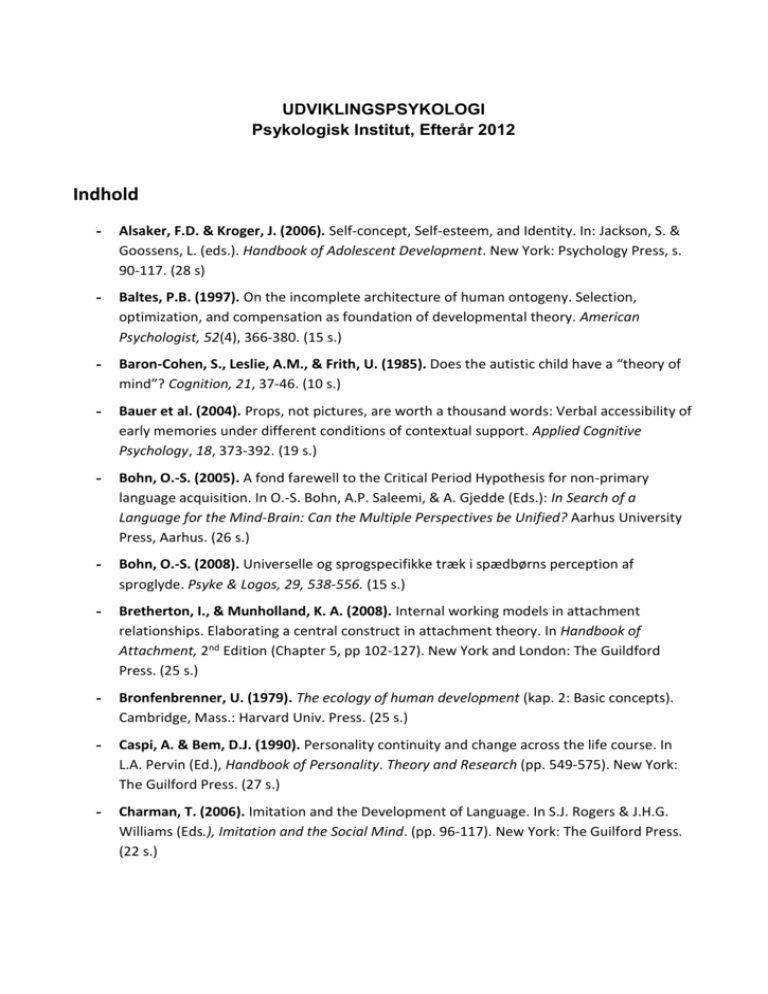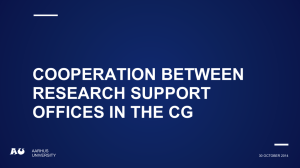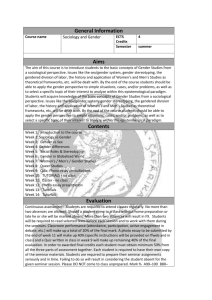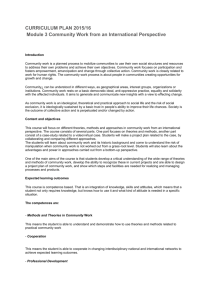Udviklingspsykologi
advertisement

UDVIKLINGSPSYKOLOGI Psykologisk Institut, Efterår 2012 Indhold - Alsaker, F.D. & Kroger, J. (2006). Self-concept, Self-esteem, and Identity. In: Jackson, S. & Goossens, L. (eds.). Handbook of Adolescent Development. New York: Psychology Press, s. 90-117. (28 s) - Baltes, P.B. (1997). On the incomplete architecture of human ontogeny. Selection, optimization, and compensation as foundation of developmental theory. American Psychologist, 52(4), 366-380. (15 s.) - Baron-Cohen, S., Leslie, A.M., & Frith, U. (1985). Does the autistic child have a “theory of mind”? Cognition, 21, 37-46. (10 s.) - Bauer et al. (2004). Props, not pictures, are worth a thousand words: Verbal accessibility of early memories under different conditions of contextual support. Applied Cognitive Psychology, 18, 373-392. (19 s.) - Bohn, O.-S. (2005). A fond farewell to the Critical Period Hypothesis for non-primary language acquisition. In O.-S. Bohn, A.P. Saleemi, & A. Gjedde (Eds.): In Search of a Language for the Mind-Brain: Can the Multiple Perspectives be Unified? Aarhus University Press, Aarhus. (26 s.) - Bohn, O.-S. (2008). Universelle og sprogspecifikke træk i spædbørns perception af sproglyde. Psyke & Logos, 29, 538-556. (15 s.) - Bretherton, I., & Munholland, K. A. (2008). Internal working models in attachment relationships. Elaborating a central construct in attachment theory. In Handbook of Attachment, 2nd Edition (Chapter 5, pp 102-127). New York and London: The Guildford Press. (25 s.) - Bronfenbrenner, U. (1979). The ecology of human development (kap. 2: Basic concepts). Cambridge, Mass.: Harvard Univ. Press. (25 s.) - Caspi, A. & Bem, D.J. (1990). Personality continuity and change across the life course. In L.A. Pervin (Ed.), Handbook of Personality. Theory and Research (pp. 549-575). New York: The Guilford Press. (27 s.) - Charman, T. (2006). Imitation and the Development of Language. In S.J. Rogers & J.H.G. Williams (Eds.), Imitation and the Social Mind. (pp. 96-117). New York: The Guilford Press. (22 s.) - Cowan, P. A. & Cowan, C. P. (2012). Normative family transitions, couple relationship quality, and healthy child development. In: F. Walsch (ed.), Normal family processes. Growing diversity and complexity. 4th Edition (pp. 428-451). NY: Guildford Press. (24 sider) - Gleason, J.B., & Ratner, N.B. (1998). Language acquisition. In J.B. Gleason & N.B. Ratner (Eds.), Psycholinguistics ( 2nd ed., pp. 347-407). New York: Hartcourt Brace. (61 s.) - Gottlieb, G. (2007). Probabilistic epigenesis. Developmental Science, 10, 1-11. (10 s.) - Hart, B.M. & Risley, T.R. (1995). Meaningful Differences in the Everyday Experience of Young American Children. Paul H. Brookes Publishing Co., pp. 119-140. (22 s.) - Harvey, J. H. & Wenzel, A. (2006). Theoretical Perspectives in the Study of Close Relationships. In: A. L. Vangelisti & D. Perlman (Eds.), The Cambridge Handbook of Personal Relationships (pp. 35-49). NY: Cambridge University Press. (15 sider) - Hobson, P. (1993). Understanding persons: The role of affect. In S. Baron-Cohen, H. TagerFlusberg & D.J. Cohen (Eds.), Understanding Other Minds. New York: Oxford University Press. (23 s.) - Howes, C. & Spieker, S. (2008). Attachment relationships in the context of multiple caregivers. In Handbook of Attachment (Chap. 14, pp. 317-332). New York: The Guildford Press. (15 s.) - Jensen, A.R. (1997). The psychometrics of intelligence. In H. Nyborg (Ed.), The Scientific Study of Human Nature: Tribute to Hans J. Eysenck at Eighty (kap.11). Oxford, England: Elsevier Science Ltd. (19 s.) - Krøjgaard, P. (2001). Økologisk validitet og eksperimentel spædbarnsforskning. Psyke & Logos, 22, 635-661. (28 s.) - Larsen, L., Hartmann, P., & Winsløv, J-H. (2007). Personlighedens stabilitet i voksenlivet. I: L. Larsen (red), Gerontopsykologi (pp. 37-60). Aarhus: Aarhus Universitetsforlag. (23 s.) - Larsen, L., & Hartmann, P. (2007). Forskningsmetodologiske problemstillinger i gerontopsykologien. I: L. Larsen (red), Gerontopsykologi (pp. 17-34). Aarhus: Aarhus Universitetsforlag. (17 s.) - Legerstee, M., & Barillas, Y. (2003). Sharing attention and pointing to objects at 12 months: Is the intentional stance implied? Cognitive Development, 18, 91-110. (20 s.) - McCrae, R.R., & Costa, P.T. (2003). A five-factor theory of personality. I: Personality in Adulthood – A Five-Factor Theory Perspective (2nd ed., chap. 10). New York: The Guilford Press. (21 s.) - Meltzoff, A.N. (1995). Understanding the intentions of others: Re-enactment of intended acts by 18-month-old children. Developmental Psychology, 31, 838-850. (13 s.) - Moore, C., & Corkum, V. (1994). Social understanding at the end of the first year of life. Developmental Review, 14, 349-372. (24 s.) - Neisser, U. et al. (1996). Intelligence: Knowns and unknowns. American Psychologist, 51, 77-101 (24 s.) - Quinn, P.C. & Oates, J. (2004). Early category representation and concepts. I: J. Oates & Grayson (Eds.), Cognitive and Language Development in Children (Chapter 1). MA: Blackwell Publishing. (38 s.) - Siegelman, C.K., & Rider, E.A. (2009). Introduction to the human life span (Chap. 1, pp. 1333). Human Development across the Life Span, 7th Edition. Wadsworth, Cengage Learning. (25 s.) - Simcock, G., & Hayne, H. (2002). Breaking the barrier? Children fail to translate their preverbal memories into language. Psychological Science, 13, 225-231. (6 s.) - Smith, L.B., & Thelen, E. (2003). Development as a dynamic system. TRENDS in Cognitive Sciences, 7, 343-348. Elsevier. (5 s.) - Tomasello, M., Carpenter, M., Call, J., Behne, T., & Moll, H. (2005). Understanding and sharing intentions: The origins of cultural cognition. Behavioral and Brain Sciences,28, 675691 (17 s). - Vernon, P.A. (1997). Behavioral genetic and biological approaches to intelligence. In H. Nyborg (Ed.), The Scientific Study of Human Nature: Tribute to Hans J Eysenck at Eighty (kap. 12). Oxford, England: Elsevier Science Ltd. (19 s.) - Wellman, H.M., & Lagattuta, K.H. (1999). Developing understandings of mind. In S. BaronCohen, H. Tager-Flusberg, & D. Cohen (Eds.), Understanding other minds: Perspectives from developmental cognitive neuroscience (second edition), pp. 21-49. Oxford University Press. (29 s). - Whitehouse, A.J.O., Bishop, D.V.M., Ang, Q.W., Pennell, C.E. & Fisher, S.E. (2011). CNTNAP2 variants affect early language development in the general population. Genes, Brain, and Behavior, 10, 451-456. (6 s.) Ud over disse er følgende tekster på pensum: - Berk, L. (2012). Child Development (9th. Ed.). Boston: Allyn and Bacon. (ca. 514 s.) - Greenfield, P.M., Suzuki, L.K., & Rothstein-Fisch, C. (2006). Cultural pathways through human development. In W. Damon, and R.M. Lerner (eds.), Handbook of Child Psychology. Vol. 4- Chap. 17, pp. 655-699). New York: John Wiley & Sons. (44 s.) - Jørgensen, C.R. (2008). Identitet. Psykologiske og kulturanalytiske perspektiver, kapitel 2: Hvad er identitet? s. 28-79. (52 s.) - Mortensen, E. L. (2007). Det aldrende intellekt. I: L. Larsen (red), Gerontopsykologi (pp. 6192). Aarhus: Aarhus Universitetsforlag. (31 s.) - Onishi, K.H. & Baillargeon, R. (2005). Do 15-month-old infants understand false beliefs? Science, 308, 255-258. (3 s.) - Perner, J. & Ruffman, T. (2005). Infants’ insight into the mind: How deep? Science, 308, 214-216. (3 s.) - Spelke, E.S. (2003). What makes us smart? Core knowledge and natural language. In: D. Gentner and S. Goldin-Medow (Eds.). Language in Mind: Advances in the Investigation of Language and Thought. Cambridge, M.A.: MIT Press. - Sommer, D. (2012). A Childhood Psychology . Basingstoke & New York: Palgrave MacMillan. Chapter 1+Chapter 7. (68 s.) - Stern, D. (2000). Spædbarnets interpersonelle verden (ANDEN DEL: De fire fornemmelser af selvet, (pp. 77-211). København: Hans Reitzels Forlag. (133 s.)




